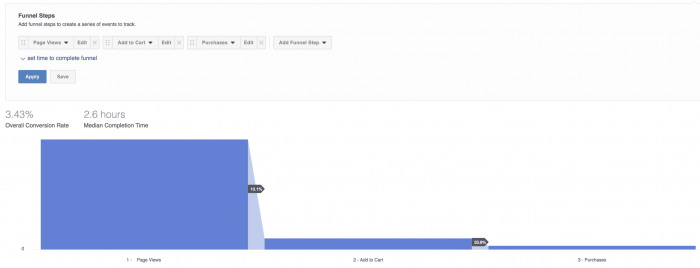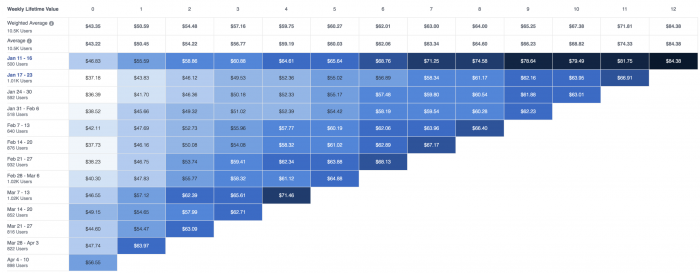I’m proud of the work I’ve done to help demystify Facebook ad tools and empower thousands of business owners and entrepreneurs with detailed information and recommendations. And one of the best tools that helps all of us understand data at a deeper level is Facebook Analytics.
Jon and I taught a Facebook Analytics course last December and we received this question, which helped prompt our thinking for a future Analytics course:
How do I take these insights and turn them into actionable steps in my campaignsThe campaign is the foundation of your Facebook ad. This is where you'll set an advertising objective, which defines what you want your ad to achieve. More?
With that in mind, this post is meant to jumpstart your campaigns and move the needle right away by covering Funnels and Lifetime Value within Facebook Analytics. We’ll take a closer look at commonly asked questions related to these reports and some potential solutions.
[If you’re wondering how to set up Facebook Analytics or generally learn more about the topic, you can read my overview post, Jon’s post on setting up events properly, or a deeper dive on reactions via Analytics. If you’re not very familiar with Facebook Analytics, I’d recommend reading those posts first!]
Funnels
Funnels within Facebook Analytics allow you to build visualized paths within your sales cycle to see how different parts of your funnel relate to one another. One of my personal favorites is using the funnel of Page View > Add to Cart > Purchase within a 90-day window.

This funnel helps me understand how all traffic that’s come through our site within the last 90 days has behaved. I can see the overall conversion rate of the funnel, the average time to complete this funnel, and much more.

Questions Related to Funnels
See below for a few examples of questions and answers that come to mind when reviewing this data.
Question 1:
Can I improve the percentages of people who view a page and then add something to their cart?
Here are a few potential solutions (this is not an exhaustive list!):
1. Launch an improved offer on the ad via the conversion objective, within the ad to Previous Page Views who didn’t add to cart. Perhaps instead of trying 10% off on remarketing to this group, change the ad copy to “add to cart and save 20% now,” offering an incentive to users to add to their cart.
2. Launch a Page Post EngagementPost engagements include all of the actions that people took on your Facebook ad post. Examples include:
• Post Shares
• Post Reactions
• Post Saves
• Post Comment
• Page Likes
• Post Interactions
• 3-Seconds Video Plays
• Photo Views
• Link Clicks
More Objective ad towards Previous Page Views who didn’t add to cart, thus reaching a wider selection of that audienceThis is the group of people who can potentially see your ads. You help influence this by adjusting age, gender, location, detailed targeting (interests and behaviors), custom audiences, and more. More. You could use that ad to explain more about what you do, what makes your product or service different, or launch a video describing it.
3. Launch a Messenger ad towards those who’ve added something to their cart but not purchased. The ad copy could be “what questions do you have?” and that ad drives them into a Messenger conversation. Sometimes users put something in their carts as they’re considering that product, so why not ask if you can be helpful?
4. Launch multiple ad types at the add to cart audience, such as a carouselA carousel allows you to display two or more scrollable images or videos in the same ad, with the ability to link each to a different URL. More ad, a photo post ad, a slideshow, and a Canvas ad. Gauge success over a testing period to see if you can improve the baseline percentage of those who ultimately become purchasers.
Question 2:
Some of my existing site traffic isn’t going to buy immediately, so what else can I do with that audience?
Potential Solutions:
1. Launch a Lead Gen ad at Previous Page Views, asking for that user’s email address. That way you can add them to your email list and use email to help them better understand your product or service.
2. Launch a video advertisement that gives more of your company backstory to those users. Help them understand who you are in a more complete, compelling way.
3. Launch an article for Page Post Engagement to that audience to help them see external validation of your product.
4. Showcase your products using an engaging Canvas ad, which combines video and photos to more completely describe who you are.
These are just a few examples of successful tactics I’ve launched using Funnels. There are many more.
Lifetime Value
One of the most valuable target groupings that surprisingly doesn’t get much attention is previous purchasers. As advertisers, we focus a lot of attention on brand new acquisition and sometimes we forget about the people who already know us. This group of customers shouldn’t be forgotten.
Compounding this problem, many advertisers do not properly calculate Lifetime Value. They focus on Cost Per Acquisition (CPA) instead of Lifetime Value, which can help provide more of a buffer when acquiring new customers versus only looking at your average order value and calculating at what cost you must obtain a new customer.
As competition rises and prices continue to increase, we must consider what a true value of a customer is over his or her lifetime. For example, let’s take a recent conversation I had with a client and break it down.
- Their average order value is ~$40.
- Their CPA goal is $20. If an ad set CPA goes above $20, they turn it off immediately.
- Their lifetime value (LTV) is $80.
- Their ads are having a hard time getting conversionsA conversion is counted whenever a website visitor performs an action that fires a standard event, custom event, or custom conversion. Examples of conversions include purchases, leads, content views, add to cart, and registrations. More at $20.
It’s a challenging conundrum because as competition rises on Facebook and Instagram, advertisers have to consider measuring their LTV, not just CPA. You can find this information via Lifetime Value within Facebook Analytics.
My first advice to them was “consider raising your CPA goal to $30.” By increasing it, you allow your ad setsAn ad set is a Facebook ads grouping where settings like targeting, scheduling, optimization, and placement are determined. More to get a higher CPA before turning them off and you’re considering the lifetime value.
Consider these LTV graphs from Facebook Analytics.


Here are a few overall observations:
- Over a 12-week period, the LTV has increased from $40 (likely their first purchase) to $84.
- The week of March 7-13, you can see those users are already at $71 for their LTV in week 4.
Question Related to Lifetime Value
Here’s a sample question on the Lifetime Value topic:
What can I do to increase Lifetime Value of these customers? How can I improve from $84 to $100+ over a 12-week period?
Potential Solutions:
1. Launch a series of ads for twelve weeks, introducing them to new products in your store.
2. Launch a Dynamic Product Ad utilizing a new product set they’ve not yet been exposed to before.
3. Do a Facebook Live showcasing new products and advertise it only to previous customers via the conversion objective.
4. Create a custom discount code only for previous purchasers to use, asking them to come back and try another product.
5. Launch a series of different objectivesWhen you create a campaign, one of the first things you'll do is select an objective. The campaign objective is your ultimate goal. Your selection will impact options, including optimization and delivery. Options include Awareness, Traffic, Engagement, Leads, App Promotion, and Sales. More, such as Page Post Engagement and ReachReach measures the number of Accounts Center Accounts (formerly users) that saw your ads at least once. You can have one account reached with multiple impressions. More at the previous customer audience to see if you’re able to touch a wider segment of that core audience.
Raising the LTV has a lot to do with storytelling, so the more you can turn customers into advocates the better.







